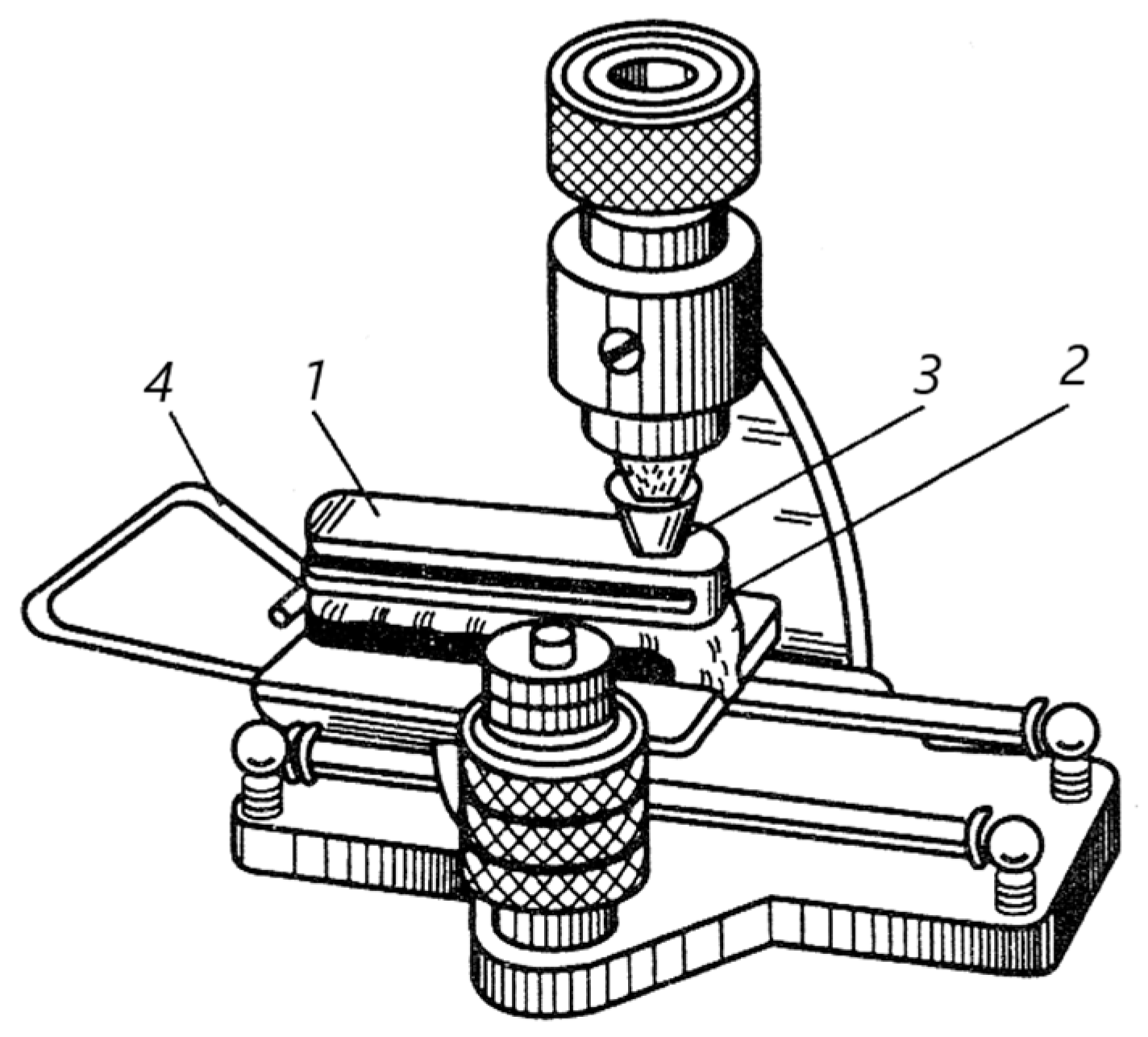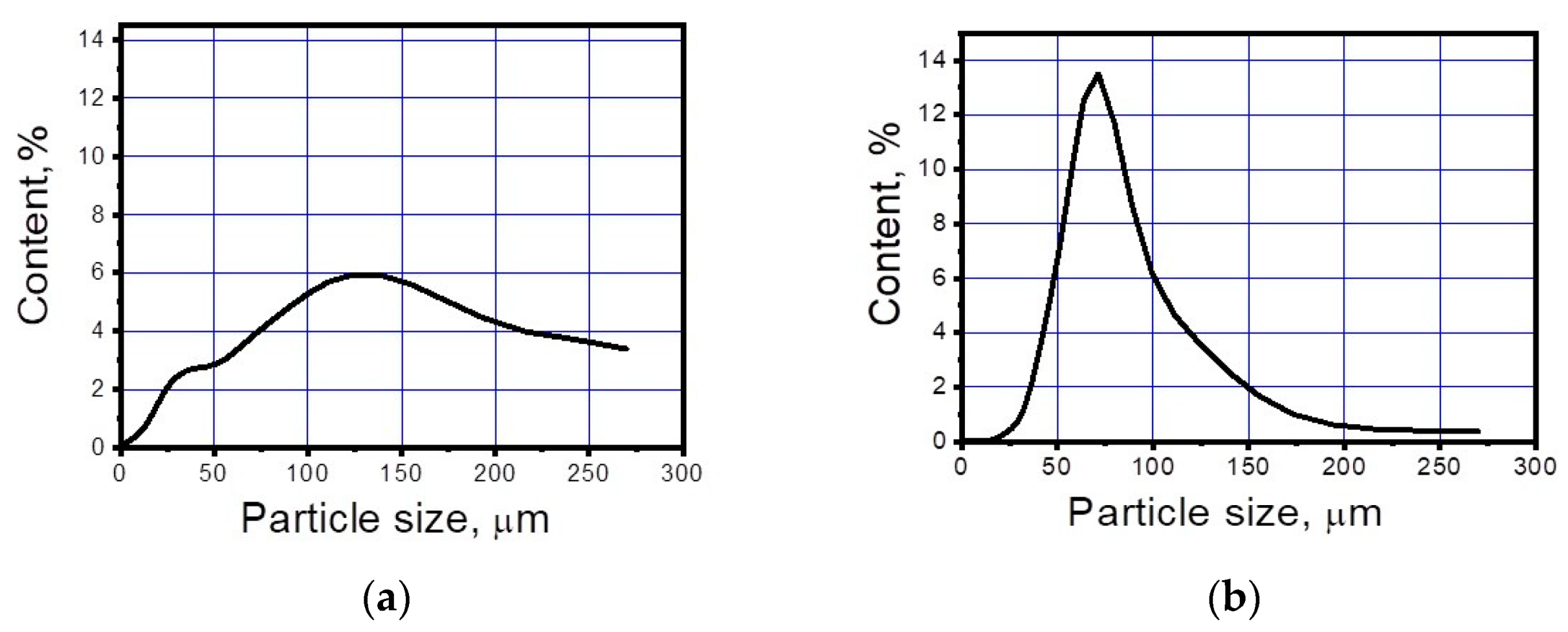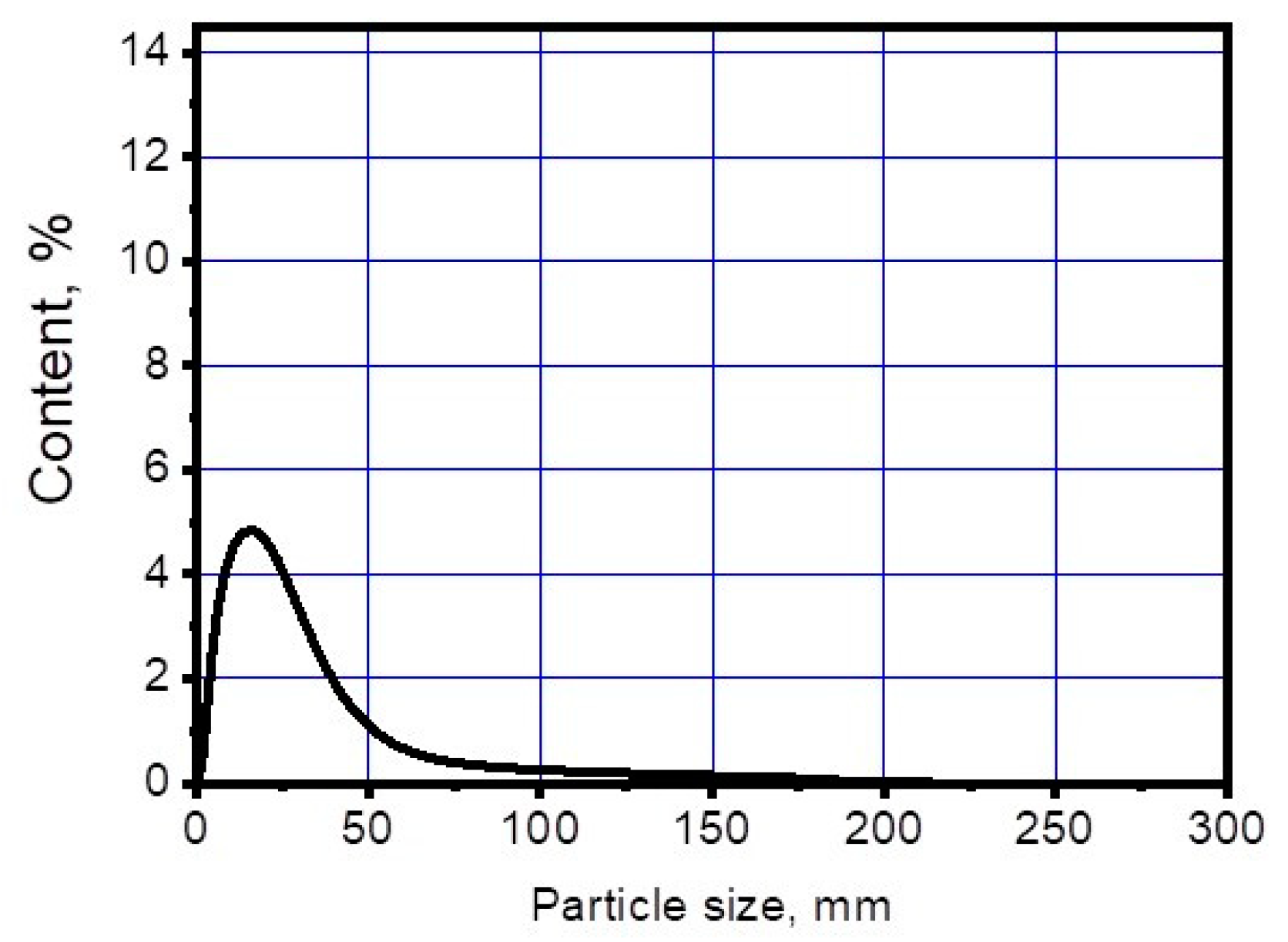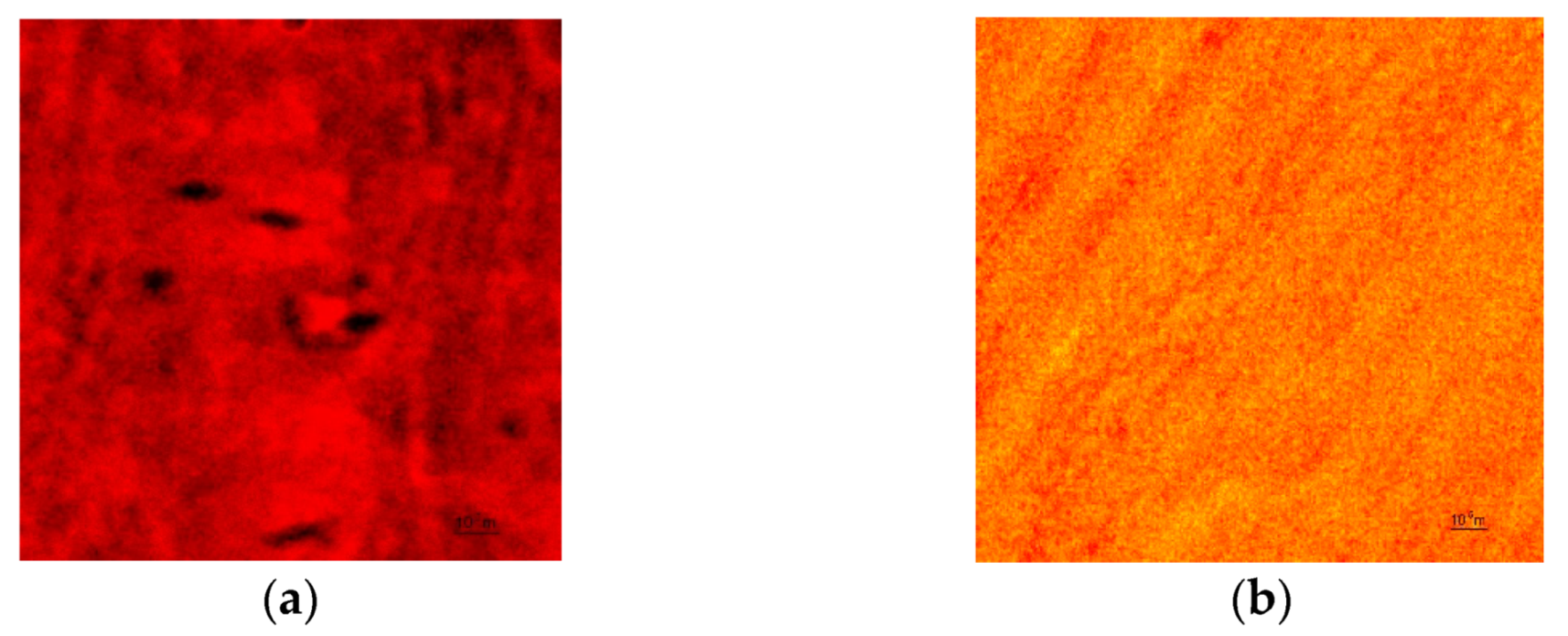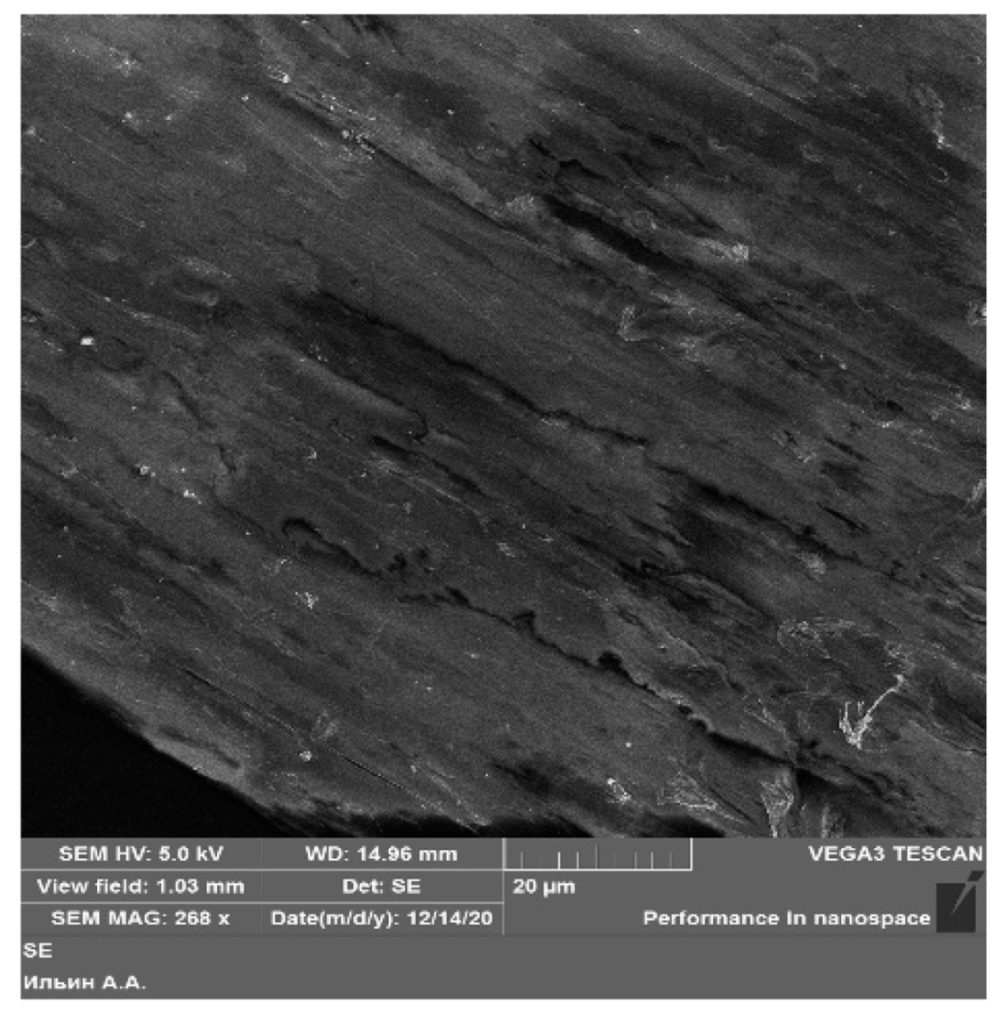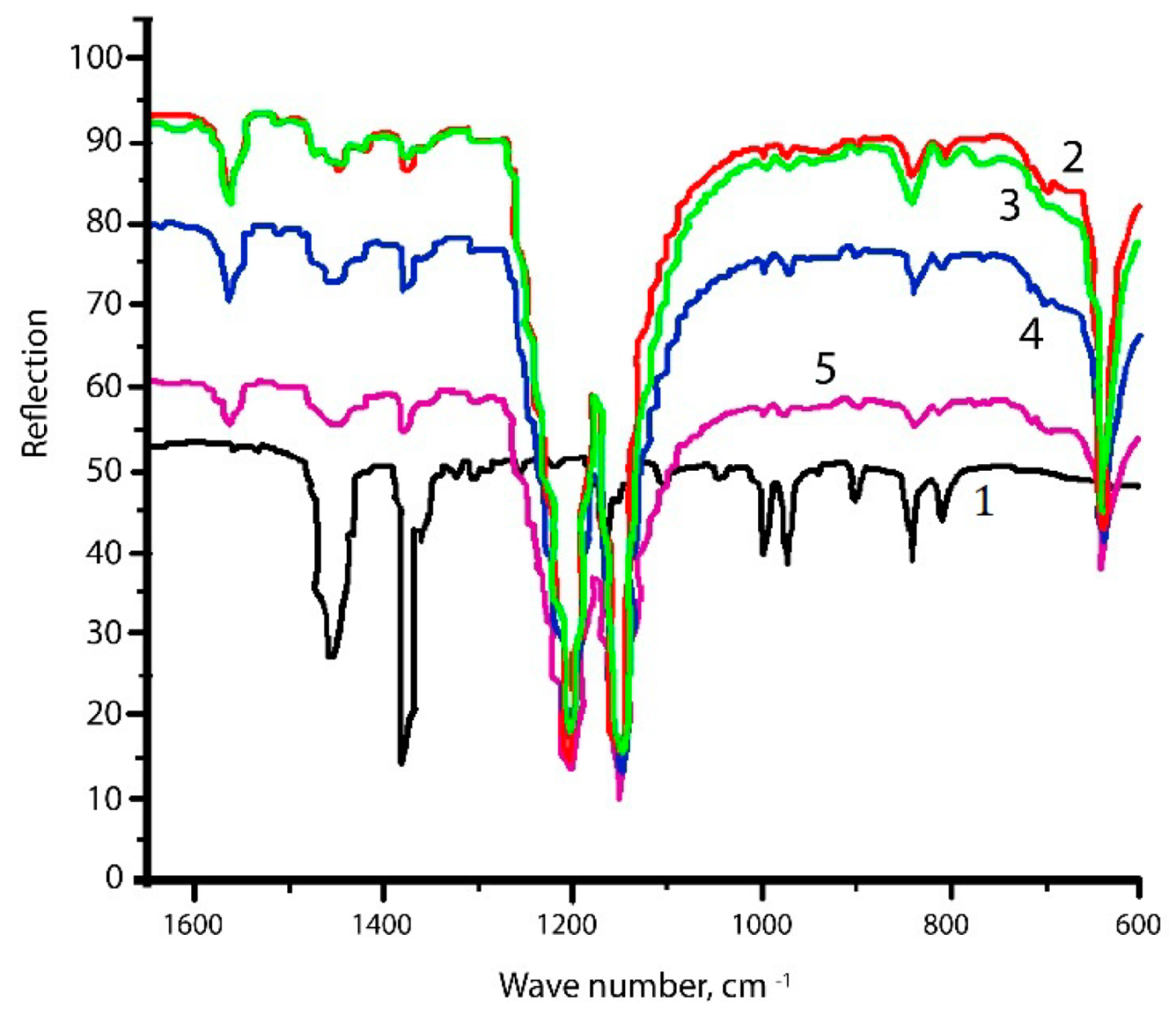1. Introduction
Single-use materials (medical wear, masks, drapes and pads, sheets, etc.) are now often used in medical practice. A very important quality of such products is their antimicrobial properties, i.e., their ability to suppress the development of pathogenic microorganisms and protect the patients and doctors who come in contact with such microorganisms. One of the most widely applied methods of providing fibrous materials with antimicrobial properties is the use of metal and metal oxide nanoparticles [
1,
2,
3,
4,
5,
6,
7] in antimicrobial preparations since they become attached to the surface of natural fibers with an enormous number of functional groups. Polypropylene (PP) fiber has a chemically inert smooth surface with no pores on it, and it is very hard to attach metal or metal oxide nanoparticles to the surface of such a fiber. However, it is known [
8,
9,
10,
11,
12,
13,
14] that nanoparticles retain their antimicrobial properties even when they are immobilized inside this polymer. Therefore, PP fibers can also be provided with antimicrobial properties by immobilizing metal-containing nanoparticles in their inner cavities. A major problem with the introduction of nanoparticles into the polymer matrix during the melt spinning of fibers is that it is natural for nanoparticles to aggregate because even a slight aggregation of the fillers may adversely affect the strength of the fibers. It is rather difficult to prevent the aggregation of nanosized fillers during the melt spinning of nanomodified synthetic filaments because the formation of nanoparticle aggregates is the result of the metastability of the nanoparticles with excessive surface energy. The proposed solutions to this problem are mainly based on lowering the surface energy of nanosized fillers by treating their surfaces with special agents [
14,
15]. Different works [
16,
17,
18,
19] propose a different approach to solving this problem. This approach consists of the introduction of a polymer composite based on antimicrobial iron-, manganese-, and silver-containing nanoparticles stabilized by polyolefins into a polypropylene melt during yarn formation. When this method is applied, the nanoparticles are uniformly distributed throughout the fiber and are firmly kept within it. However, the stabilization method for metal-containing nanoparticles in their introduction into a polyolefin matrix during the synthesis procedure is rather complicated, which is an obstacle to their application in the preparation of modified PP yarns with antimicrobial properties. However, the use of unstabilized metal-containing nanoparticles for these purposes reduces yarn strength and, in case of large aggregate formation, leads to the clogging of the spinnerettes and yarn breakage.
The aim of this work was to attach nanoparticles firmly to the PP yarn surface instead of immobilizing them inside the yarn. In this way, we can exclude the negative effects of the aggregated nanoparticles on the strength of the yarn and can increase the antimicrobial effect by localizing the biologically active nanoparticles on the surface. To do this, we introduced nanoparticles into the thin polymer coatings formed on the yarns.
There are various methods of forming thin and elastic polymer coatings on fibrous materials for the direct change of their properties: in situ polymerization, vapor deposition, dipping in a solution, etc. [
20,
21,
22]. We had earlier proposed a fundamentally new approach to obtaining PP yarns with a polytetrafluoroethylene (PTFE) coating [
23,
24,
25]. According to this approach, PTFE adhesion to the surface of a thermoplastic yarn is achieved by depositing a suspension of finely dispersed PTFE on the surface of a semi-solidified yarn at the stage of its formation on the polymer (oiling stage). At the orientational drawing state, the coating then becomes much thinner due to the fluoroplastic pseudofluidity and high coefficient of thermal expansion, which causes the coating to become uniform and oriented. Such a continuous and uniform PTFE coating makes the yarn extremely chemoresistant, similar to a fluoroplastic yarn. We supposed that the introduction of a small number of antimicrobial metal-containing nanoparticles into the PTFE coating structure could provide the yarn with additional functional characteristics: the yarn could become antimicrobial, retaining its high chemoresistance. Moreover, the introduction of metal-containing nanoparticles into the coating structure might reduce the electrical resistance of the yarn surface. To achieve this effect, we introduced a controlled number of biologically active magnetite (FeO·Fe
2O
3) nanoparticles into a PTFE suspension. To prevent the formation of large aggregates of magnetite nanoparticles, we stabilized them with a surfactant in advance. Since the orientational drawing of the yarn is carried out at temperatures up to 250 °C, we chose sodium stearate (NaC
18H
35O
2) for the magnetite stabilization, as preliminary studies had shown that it is a thermally stable surfactant
. The obtained composition was deposited on a semi-solidified PP yarn and then subjected to orientational drawing.
2. Materials and Methods
The following materials and reagents were used in this work: granulated “Balen 01250” polypropylene with a melt index of 25 g/10 min and a melting point of 169 °C (Ufa, Ufaorgsintez, technical requirements No. 2211-015-00203521-99); sodium stearate (NaC18H35O2), “pure”; ferrous sulfate heptahydrate (FeSO4∙7H2O), “chemically pure” (Moscow, Chimmed); iron trichloridehexahydrate (FeCl3∙6H2O), “pure” (Moscow, Chimmed); ammonium hydroxide (NH4OH), 25%, “pure”; and a suspension of CΦ-4Д (SF-4D) polytetrafluoroethylene (AO Galopolymer, Russia). In some of the experiments, we used a film made of 30 µm thick “Balen 01250” isotactic polypropylene (Europack-Ivanovo Ltd.» Ivanovo, Russia) as the PP yarn model.
The magnetite nanoparticles were prepared by codepositioning. For that purpose, we first prepared a solution of two salts containing 7.08 g FeSO4∙7H2O (C = 0.5 M) and 3.75 gFeCl3∙6H2O (C = 0.3 M), heated it to 80 °C and while mixing this solution, slowly added an excessive amount 15 mL (C = 1.5 M) of ammonia solution, NH4OH, to it. The stabilization resulted in the production 1.0% NaC18H35O2. Mixing the solution led to the appearance of black ultrafine particles. The mixture was then repeatedly washed with distilled water until the ammonia smell disappeared. The suspension of the stabilized magnetite was then dried in air until a powder was produced. The powder was sifted through a filter and dried for 24 h in a vacuum at a temperature of 60 °C.
The composition for coating the PP yarns was obtained from a finely dispersed suspension of SF-4D PTFE by mixing the components at a temperature of 80–90 °C. The composition contained a PTFE suspension-10%, sodium stearate-1.0%; magnetite-1%; and water-88%. To make the aggregates of the stabilized magnetite particles smaller, we subjected them to ultrasonic (US) treatment in a low-frequency ultrasonic sonicator of the USDN-2T type in a temperature-controlled container at a frequency of f = 22 kHz. The exposure lasted for 2 min.
The PP yarns were prepared using a laboratory bench for the SFPV-1 synthetic fibre spinning. The orientational drawing of the spun PP yarns was performed on an OSV-1 synthetic fiber orientation bench. Such benches can simulate the conditions of the industrial processes for yarn melt-spinning and orientational drawing. The images and schemes of the benches are presented in previous works [
16,
25].
The SFPV-1 spinning bench is equipped with an automated control panel for managing the spinning process, an extruder in which the polymer melts, a spinnerette with 24 holes (Ø = 0.4 mm) for the formation of fine jets of liquid from the melt, godet wheels, and a fibre collecting drum for winding the spun yarn onto a spindle. During the experiment, the temperature values in the extruder zones were different: in the preheating zone, T1 = 200 °C; in the melting zone, T2 = 225 °C; in the melt stabilization, zone T3 = 236 °C; and in the extrusion head heating zone, T4 = 236 °C. The melt was fed at a rate of 20 g/min. The godet wheels operated at 100 m/min.
The composition containing a PTFE suspension and magnetite nanoparticles stabilized by a thermally stable surfactant was deposited on the PP yarn surface from the first and second godets at the oiling stage.
After the extrusion and deposition of the PTFE composition, the PP yarns were subjected to orientational drawing and were thermally stabilized on an OSV-1 bench. The process was carried out for the standard PP yarn at the following temperatures in the stretching zones: T
1 = 118–120 °C (the upper heated godet wheel), T
2 = 120–122 °C (the lower heated godet wheel), and T
3 = 123–125 °C (the thermoelectric plasticizer) at a rate of 3–20 m/min. The coated yarns were stretched at higher temperatures: T
1 = 120–135 °C, T
2 = 123–140 °C, and T
3 = 125–155 °C. Complex yarns composed of 24 filaments with a diameter of 15 µm were obtained. The coating thickness was 0.18 ± 0.5 μm. The characteristics of the PTFE coating are described in detail in [
25,
26].
In some of the experiments, the composition was deposited on the surface of a polypropylene film produced in industrial conditions from 30 µm thick “Balen” 01250 polypropylene (Europack, Ivanovo, Russia). The film became 5 times longer after being stretched on the OSV-1 bench at 120 °C.
The size of the magnetite particles in the suspensions and powders was determined with the Analysette 22 Compact, a laser light scattering particle size analyzer. The particle size range was 0.3–300 µm.
The basic mechanical characteristics of the PP yarns were determined by stretching the yarns once until breakage on a modernized 2099-P-5 tensile testing machine (“Tochpribor”, OAO, Russia) in accordance with GOST 6611.2-73 (ISO 2062-72, ISO 6939-88).
The micrographs of the PP yarns were obtained using an optical microscope (equipped with a webcam (1.3 MP)) produced by “Biomed” (Russia). The surface structure was studied on a JSM 6380LA scanning electron microscope produced by JEOL.
The IR spectra were recorded on an Avatar ESP 360 type spectrometer (produced by the Nicolett company) with the method of multiple attenuated total reflectance (MATR) using a zinc selenide crystal with a 12-fold reflection in the range from 600 to 1600 cm−1. This region contains the reflection band characteristics of PTFE and PP.
To make sure that the coating is resistant to abrasion, we used a PP film as a model of the PP yarn. The measurement was made on a PT-4 apparatus, a special machine for determining dye resistance to friction, according to the procedure described in [
15]. The schematic diagram of the PT-4 apparatus is shown in
Figure 1. The abrasive effect occurred during the simultaneous action of the normal applied load and the shear load produced by the application of a horizontal force. A film sample (1) was placed on the apparatus stage (2) and abraded with a calico piece fixed onto the protruding rubber stopper (3). The friction was the result of shifting the stage by 10 cm by pulling the stage handle (4) forward and backward a required number of times. The total force applied by the stopper to the stage was 9.8 N.
The surface electrical resistance of the yarns (
R) was determined with an IESN-1 apparatus, in which the measurements were made by a E6-13A teraohmmeter. The distinguishing feature of this apparatus is that one layer of the yarn is wound closely onto the sensor before the measurements. The sensor with a yarn wound onto it is mounted onto a dielectric support and is connected to the teraohmmeter. The electrical resistance measurements were made in accordance with ΓOCT 19806-74 (GOST 19806-74: a method of electric resistance determination using chemical threads). The specific surface electrical resistance was calculated by the formula:
where
k is a constant; for the IESN-1 apparatus,
k = 903.5 g
3/mm
8;
T is the linear density of the yarns, tex;
γ is the yarn density, mg/mm3;
R is the average electrical resistance value, ohm.
The effect of the modified fibrous material on the activity of pathogenic microorganisms was evaluated using typical test cultures:
Staphylococcus aureus 6538-P ATCC=209-P FDA and
Escherichia coli, strain M-17—Gram-positive and Gram-negative bacterial cultures, respectively, and
Candida albicans CCM 8261 (ATCC 90028), a yeast-like microscopic fungi. A standard yarn sample was placed into a physiological solution containing a certain number of microbial colonies in the form of a suspension [
27]. We kept the vials at room temperature for 24 h with constant shaking. The number of microbial colonies that the solution contained was determined by the changes in the solution transmission coefficient (the reference sample was assumed to have a 100% transmission coefficient), which was obtained by measuring the solution turbidity depending on the number of the colonies it contained. The reduction in the microbial contamination of the test objects relative to that of the reference object (saline) was evaluated in points: 1 point (0.0–0.1%) indicated that there was no antimicrobial effect; 2 points (0.1–90%)—a slight decrease in the number of microorganism colonies, an insufficient antimicrobial effect; 3 points (90–94%)—a significant reduction in the number of microorganism colonies, a good antimicrobial effect; 4 points (95–98%)—a significant reduction in the number of microorganism colonies, a very good antimicrobial effect; and 5 points (99% and higher)—a strong reduction in the number of microorganism colonies, an excellent antimicrobial effect.
The chemical resistance of a PP yarn with a PTFE coating was evaluated by measuring its tensile strength after it was exposed to aggressive liquids—a concentrated solution of sodium hydroxide (5 mol/L) at a temperature of 100 °C for 3 h and concentrated nitric acid (69%), also acting as a strong oxidizer, at a temperature of 25 °C for 24 h.
The resistance of a PP yarn with a PTFE coating to washing was assessed by the change in its specific tensile strength after repeated washings by being stirred in a solution of oleic soap (85%)—5 g/L and Na2CO3—2 g/L. The duration of each wash was 30 min, the temperature of each wash was 60 °C.
3. Results and Discussion
The supramolecular structure of melt-spun PP yarns is known to depend on the conditions of their spinning and orientational drawing [
28,
29,
30]. Spinning leads to the formation of folded lamellar crystallites [
30,
31], which means that the resulting non-oriented yarns have extremely low strength and high (up to 1000%) elongation. At the orientational drawing stage, they become oriented, and the molecular chains in the lamellae completely unfold, forming fibrillar crystallites from the extended chains [
32]. The better oriented the fibrils along the filament axes, the higher the yarn strength is. A yarn with a “perfect” and highly oriented structure and high strength can only be obtained by intensive orientational drawing. Its implementation, to a large extent, depends on the temperature and surface properties of the yarn. Depositing a PTFE coating on a PP yarn makes it possible to carry out its orientational drawing at higher temperatures than those used for a standard PP yarn. This makes the yarn strength parameters better [
25,
26]. However, it is necessary to find out how doping the PTFE coating with magnetite particles, namely the size of these particles, affects the yarn strength.
Smaller particles are known to have higher surface energy. This leads to the strong aggregation of the nanoparticles during their spinning and use. Such aggregates lead to the deterioration of a number of properties, in particular, they reduce the biological activity of nanosized particles. To avoid this, we stabilized the nanoparticles with a surfactant. When selecting the surfactant, we took into account that a PP yarn with a coating containing magnetite nanoparticles is subjected to orientational drawing at a temperature above 250 °C. For this reason, we chose sodium stearate, which is known to decompose at 300 °C and is resistant to oxidation. The stabilizer effect on the magnetite particle size and size distribution was determined based on the data given in
Figure 2.
It was found that the air drying of magnetite that is synthesized without a stabilizer leads to intensive particle aggregation. The measurement of the particle size distribution (
Figure 2a) showed that the formed aggregates were up to 275 µm in size. Most of them were 150 µm in size. The use of sodium stearate as the stabilizer during the magnetite synthesis led to a considerable reduction (to 60–75 µm) in the average size of the aggregates that were formed (
Figure 2b).
To make the aggregated particles of the magnetite even smaller, the magnetite suspension in water containing a surfactant was subjected to ultrasonic (US) treatment. The size distribution of the magnetite particles after the US treatment is shown in
Figure 3.
Figure 3 shows that additional US treatment of the magnetite particles stabilized by sodium stearate reduces the average size of the aggregates to 15–25 µm, which can have a positive effect on the magnetite particle distribution in the PTFE coating.
To evaluate the effect of the magnetite particle sizes on the basic mechanical characteristics of the PP yarns, we measured the specific tensile strength and relative breaking elongation of the yarns coated with magnetite particles doped with non-stabilized and stabilized sodium stearate. For comparison, we also present the mechanical characteristics of the coated yarns after US treatment. The obtained data are shown in
Table 1.
Table 1 shows that doping coating with magnetite somewhat lowers the strength of the yarns. This phenomenon is associated with the fact that the composition contains magnetite aggregates that build into the coating structure, leading to the formation of microdefects in the coating. In the presence of a stabilizer, the strength reduction is not as great as it is without it, which is caused by smaller size of the magnetite aggregates. Ultrasonic treatment of the composition makes the magnetite aggregates even smaller. Consequently, the magnetite does not produce a negative effect on the strength of the yarn with a PTFE coating. A detailed analysis of the mechanical characteristics of the PP yarns with PTFE coating containing stabilized magnetite particles is presented in our previous work [
33].
An additional confirmation of the fact that the composition after US treatment does not contain large magnetite aggregates is the micrographs shown in
Figure 4.
Figure 4 shows that the coating formed by the composition that has not been subjected to UV treatment (a) contains small aggregates (of up to several µm in size) of magnetite stabilized by sodium stearate. The small sizes of the aggregates are the result of the preliminary stabilization of the magnetite particles by sodium stearate. UV treatment of such composition (b) leads to aggregate destruction. The resulting coating has a uniform structure without any inclusions.
Figure 5 shows a scanning electron microscopy image of the coating containing PTFE and magnetite stabilized by sodium stearate formed by the UV-treated composition. The image also indicates that the coating structure is uniform and does not have any noticeable foreign inclusions.
Materials made from PP and PTFE are known to become strongly electrified while being processed and utilized. That is why we assumed that the introduction of even a small number of conductive magnetite particles into a PTFE coating could reduce the surface electrical resistance of PP yarns and films and, consequently, lower their ability to become electrified.
Table 2 shows the results of the surface electrical resistance measurement in the PP films with the PTFE coatings containing magnetite.
As
Table 2 shows, the inclusion of large unstabilized magnetite particles in the PTFE coating structure does not lower the electrical resistance of the film structure. At the same time, the films with a PTFE coating doped with stabilized magnetite particles have a much lower surface electrical resistance than the PP films and films with an undoped PTFE coating.
An important thing to note is that the minimum surface electrical resistance is characteristic of films with a coating formed by a US-treated composition, i.e., the one containing magnetite particles of the minimum size. This composition was used in the further experiments.
One of the most important properties of the PP yarns with a PTFE coating doped with magnetite nanoparticles is their ability to suppress the activity of pathogenic microorganisms. Stabilized magnetite particles build themselves into the coating structure and cannot diffuse outside of it. That is why we evaluated the antimicrobial properties of the coated yarns using the calculation procedure normally used for determining the antimicrobial properties of nonmigrating preparations [
27]. The reduction in microbial contamination of the test objects in comparison to the same indicator in the reference object (physiological solution) was evaluated in points. The results of the evaluation of the activity of the PP yarn with a PTFE coating containing magnetite particles against the test Gram-positive and Gram-negative bacteria are shown in
Table 3.
Table 3 shows that the formation of a PTFE coating with high anti-adhesion characteristics provides the PP yarn with weak antimicrobial properties. The introduction of magnetite nanoparticles into the coating structure significantly strengthens the antimicrobial activity of the yarn. The coated yarns considerably reduce the number of pathogenic bacterial communities, i.e., the yarns with a PTFE coating containing magnetite particles exhibit excellent antibacterial activity against
Escherichia coli—a type of Gram-negative bacteria—and
Staphylococcus aureus—a type of Gram-positive bacteria. The yarn also produces a satisfactory inhibiting effect on the activity of the
Candida albicans microfungi. It should be said that the antimicrobial action of a modified yarn is triggered by its direct contact with microorganisms, i.e., PP fibrous materials with a PTFE coating containing stabilized magnetite particles possess barrier antimicrobial properties.
As is known, during its formation, processing, and role in goods production, a yarn is subjected to severe mechanical effects. One of the most important effects is aging. That is why it is necessary to evaluate the coating resistance to abrasion.
Since a single filament of a PP yarn has a small diameter (~15 µm) and its surface is characterized by a great curvature, the PP substrate interaction with a PTFE coating was studied on a model object—a PP film with a PTFE coating doped with stabilized magnetite. To study the coating resistance to abrasion, we subjected the films to abrasion on a PT-4 apparatus. The residual amounts of the coating on the film were determined by the presence of intensive bands associated with the CF
2 group vibrations (1211 and 1154 cm
−1) in the spectra [
34], using the IR-spectroscopy method (MATR).
Figure 6 shows the IR-spectra (MATR) of the PP films with PTFE coatings doped with magnetite stabilized by sodium stearate after subjecting the films to abrasion a different number of times.
As
Figure 6 shows, the spectra of all of the films subjected to abrasion have bands that are characteristic of PTFE.
Figure 5 shows that the magnetite particles are built into the coating structure and make up its integral parts. Thus, it can be concluded that even after intensive abrasion, the films retain their fluoroplastic coating doped with stabilized magnetite. Applying the baseline method, we calculated the PTFE content on the film surface subjected to abrasions of different intensities. The internal standard for isotactic polypropylene was the band at 1460 cm
−1 [
35], and for measuring the PTFE content—the band at 1211 cm
−1. The results of the calculation are given in
Table 4.
An analysis of the data presented in
Table 4 shows that the coating is highly resistant to abrasion. Even after 500 cycles of abrasive action, the fluoroplastic layer thickness becomes only slightly thinner.
To determine whether the PP yarn with a PTFE coating retained its extremely high chemical resistance after the introduction of a small amount of stabilized magnetite into the coating structure, we measured the changes in its tensile strength after long-time exposure of the yarns to aggressive liquids—concentrated solutions of sodium hydroxide and nitric acid, with the latter acting as a strong oxidizer at the same time. The obtained data are given in
Table 5.
Table 5 shows that the strength of a standard PP yarn subjected to the action of concentrated alkalis and acids becomes 8–27% lower. The effect of aggressive liquids on the PP yarn with a PTFE coating does not lead to a loss in strength. Moreover, it makes the strength higher. As work [
25] shows, the higher strength of the yarn after its exposure to chemically aggressive liquids is the result of removing the excessive amount of PTFE that is weakly bound to the PP substrate from it. As a result, it makes the coating structure even more uniform and its surface smoother. The chemical resistance of PP yarns with a PTFE coating doped with stabilized magnetite is not lower than that of PP yarns with an undoped PTFE coating. Thus, a PP yarn with a PTFE coating doped with magnetite retains its extremely high resistance.
PP yarn with a PTFE coating, and therefore products made from it, have a very high resistance to washing. Tests have shown that the specific tensile strength of such yarns remains unchanged after 40 washes that are 30 min in duration.
